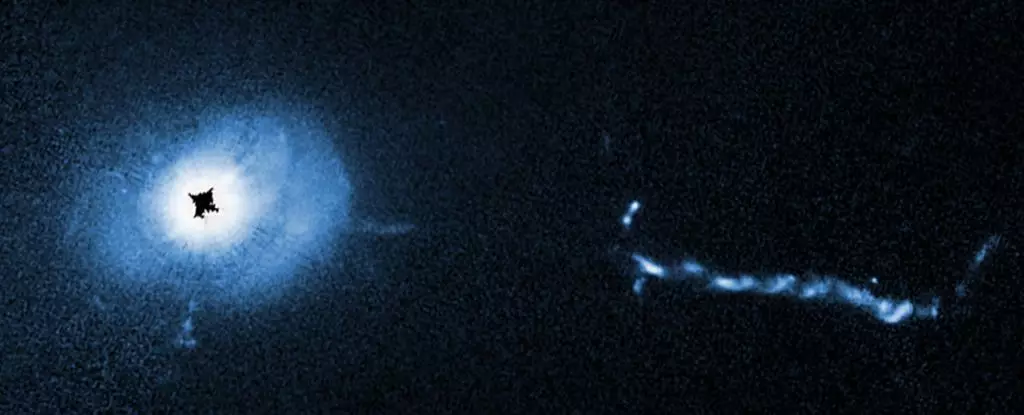The universe is dotted with countless astronomical phenomena, yet few inspire as much awe and curiosity as quasars. A recent examination of 3C 273, one of the most brilliant quasars visible from Earth, has provided unprecedented insights into these enigmatic celestial entities. At a distance of approximately 2.5 billion light-years, 3C 273 is a linchpin for understanding the intricate mechanics that govern quasars, illuminating the depths of space with the energy of trillions of suns. Utilizing the Hubble Space Telescope, astronomers have peered deeper into its heart than ever before, uncovering details that have long eluded scientists.
Quasars, short for “quasi-stellar objects,” represent some of the universe’s most luminous beacons, rivaling gamma-ray bursts and supernovae. They are powered by supermassive black holes at the cores of galaxies, which, paradoxically, do not emit light. Instead, they pull in surrounding gas and dust, forming an accretion disk that gets heated to extreme temperatures due to gravitational and frictional forces. This process results in powerful emissions across the electromagnetic spectrum. What astronomers observe when they look at quasars is, essentially, the brilliant blip of material spiraling into the abyss—a fleeting yet spectacular glimpse of energy.
While many quasars are located at great distances, 3C 273 holds a prominent place among them due to its brightness. It stands out as a beacon even from billions of light-years away, making it a prime candidate for astronomical studies.
With Hubble’s advanced imaging technology, astronomers undertook a detailed analysis of 3C 273 that went far beyond previous observations. By employing the Space Telescope Imaging System (STIS) to act as a makeshift coronagraph, researchers were able to filter through the overwhelming brightness of the quasar’s core. This technique is akin to shielding one’s eyes from a glaring light source, enabling clearer views of surrounding structures otherwise obscured by intensity.
The results of this latest study are nothing short of groundbreaking. The observations offered a resolution eight times greater than had ever been achieved before, allowing scientists to identify previously concealed features in the quasar’s vicinity—spanning a radius of about 16,000 light-years. Among the discoveries are small groupings of matter that may represent satellite galaxies or fragments being consumed by the quasar, as well as a new core jet and an unidentified L-shaped filament.
One particularly fascinating aspect of these discoveries revolves around the astrophysical jet emitted by the black hole’s magnetic interplay with its environment. This jet traverses intergalactic space, stretching an astonishing 300,000 light-years away from the quasar’s nucleus. The new measurements have documented this jet’s motion over a 22-year timeline, indicating that its velocity increases with distance from the black hole. Such findings raise numerous questions about the nature of quasar jets and their roles in galactic evolution.
Scientist Bin Ren from the Côte d’Azur Observatory emphasized the transformative nature of Hubble’s observations, highlighting their importance in bridging gaps between small-scale and large-scale astrophysical studies. With a more detailed understanding of quasar structure and dynamics, researchers can forge connections between quasar behavior and the broader phenomena occurring in the universe.
The advancements provided by the Hubble telescope facilitate newfound investigations into the realm of quasars, potentially altering our comprehension of these cosmic titans. As scientists digest the implications of 3C 273’s hidden features and jet dynamics, the research fosters a deeper understanding of quasar host morphology and their interactions within galaxies. The pathway to understanding quasars is complex, but Hubble’s contributions are paving the way for more detailed studies.
The quest to unravel the mysteries locked within quasars is only just beginning. The discoveries made through 3C 273’s enhanced observations will undoubtedly inspire further exploration and collaborative research. As astronomers continue to probe the universe’s depths, each finding serves to illuminate not just the quasars themselves but our place in the cosmos at large, reinforcing the notion that even amidst darkness, there is brilliance waiting to be uncovered.


Leave a Reply